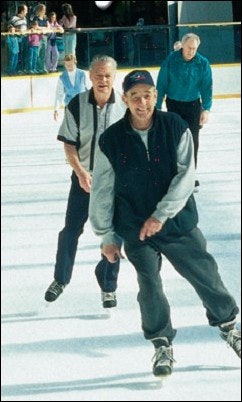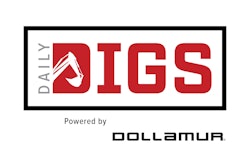After Salt Lake, Rink Operators Are Looking to Capitalize on Renewed Winter Sports Enthusiasm

A record number of American champions, a wave of patriotic sentiment and several headline-grabbing controversies combined to help make February's Salt Lake Winter Olympics the most popular ever. Winter sports have captured the general public's interest like never before, leading individuals across the country to consider trying such activities as hockey and figure skating. Meanwhile, ice facility operators are poised to take advantage of that curiosity, especially since they enjoy one of the shortest seasonal periods of peak activity in the recreation business. Traditionally, rinks are busiest in the fall and winter seasons. "People don't really think about coming inside when it's nice out," says Julie Alexander, program director at the Nelson Recreation Center in Springfield, Ill. "When it's 70 or 80 degrees outside, they don't want to go ice skating."
Cost, too, remains a deterrent for many people. "Ice hockey and skating are not cheap sports," says Jason VanBuskirk, director of program marketing for Taylor, Mich.-based sports facility management firm JRV Management, noting that only individuals with ample discretionary income are typically able to participate regularly in such activities. "To reach out to other people who might not have the resources, you have to provide new programs. You want to reach out to all the masses."
The trick, then, to capitalizing on that heightened interest and turning winter sports spectators into participants lies within marketing and programming strategies. In years past, ice facility operators were satisfied with building rinks and leasing ice time to outside organizations such as figure skating schools and hockey camps. Finding this relaxed approach ineffective, not to mention potentially lethal to their businesses, industry professionals are now taking it upon themselves to draw crowds to their facilities. "Some of the privately owned facilities have become much more sales-oriented," says Peter Martell, executive director of the Ice Skating Institute (ISI), a nonprofit trade association based in Dallas. "By that, I mean there are now facilities that have a sales or marketing director, whose responsibilities not only involve promoting and marketing the facility through advertising, but also include doing outside group sales. They're going out into the community and getting into every daycare facility, YMCA, school, preschool - every organization they can make a pitch to." As part of their presentations, marketing directors often leave behind discount coupons and flyers to entice groups to visit their facilities.
Rinks located in professional hockey team markets, such as Ice Sports Forum in Brandon, Fla., may enjoy added benefits. "Besides partnering with local businesses and schools, we are fortunate enough to be the practice facility for the Tampa Bay Lightning," says Brenda Scholl, assistant general manager. "So at all Lightning home games, we set up a booth and market to their fans."
Ice facilities are also hiring staff members to coordinate, promote and administer the various skating and hockey programs they offer. Because adding experienced, professional employees may be viewed as a drain on a facility's operations budget, Martell suggests offering directors compensation packages with lesser base salaries but featuring attractive commission-earning opportunities. "Facilities aren't hiring these people at $50,000-a-year salaries," he says, adding that operators can offer lucrative incentives to marketing personnel for generating increased attendance at public skating sessions, for example. "There are all sorts of ways a facility can structure it so that the payroll burden isn't intolerable. If marketing directors don't sell, they don't earn. But if they sell, both parties are winners."
The same can be said of hockey and figure skating program directors. "As the school grows, the director's income grows," Martell says. "There's a vested interest on the part of the director to devote a good deal of his or her time to making sure the school grows." In addition, a facility can provide its directors opportunities to earn extra income through private instruction, league refereeing or coaching. Says Martell, "Paid professionals, as opposed to volunteers, feel they are more in control of their facility's destiny."
While some ice facilities are destined to experience periods of lagging business - offering dry-floor activities such as conventions and trade shows, concerts, graduation ceremonies, and inline hockey and skating to make ends meet - those employing commission-earning staff will likely see their seasons extended by several weeks. "The off-season does give them some time to plan for next year," Martell says of marketing and program directors. "But my guess is that they don't like that." Commission-earning employees would rather keep their rinks full during those traditionally non-peak periods, he adds.
In cold-weather climates, hockey leagues in the spring and summer, for example, are becoming as common as they are in the fall and winter months, particularly for high school players who want to practice while in between scholastic seasons. Learn-to-skate programs for adults as well as youths present ideal opportunities for families wanting to play together during summer vacations. Entertaining public skating sessions that revolve around such themes as the Olympics or country-western music also have the potential to attract a variety of patrons, regardless of time of year. Rinks operated by Polar Ice Entertainment, a Tempe, Ariz.-based management company, offer such public skating sessions - complete with a deejay and special lighting effects - from Friday nights through Sunday afternoons. "But our deejays aren't just up there to play music," says Polar Ice president Brad Berman. "They play games, give out prizes and ask trivia questions. It's more than saying, 'There's the ice, now go skate around in a circle and when you're done, throw your rentals up on the counter.' We try to host a party and give people an experience they'll enjoy."
Although limited by small marketing budgets, public facilities, too, have found ways to better serve their customers. The Nelson Recreation Center, which is operated by the Springfield Park District, shares a budget of approximately $4,000 with an adjoining swimming pool. So with the February opening of its second ice rink - which includes seating for 500 spectators, a concessions stand, a skate rental shop, locker rooms and a small office - the staff at the Nelson Center reorganized, adding a few key employees in the process, including a general manager. Whereas formerly, Alexander was burdened with both the facility's marketing and programming duties, the changes have freed her to concentrate solely on the Nelson Center's programming.
In addition to offering more public skating sessions and hockey leagues, Alexander is now dipping into the creative well to develop programs she hopes will make the Nelson Center's newest ice sheet a rewarding addition. "Broomball is a sport we had here years ago that we're going to bring back," she says of the hockey-like game in which players slide across the ice on rubbersoled shoes, pushing a rubber ball toward opposing goals with modified broomsticks. "Those people are anxious to get on the ice."
Apparently, such efforts are beginning to pay off for both private and public facilities. In 1999, the ISI queried more than 1,000 facility operators across the country about the lengths of their seasons, and 74 percent of private rinks responding said they operate between 50 and 52 weeks a year. Meanwhile, 66 percent of public facilities were operating somewhere between 40 and 52 weeks. ISI officials are expecting its latest survey, to be released this month, to show an increase in season lengths for both types of facilities. "What we're finding is that more rinks are operating on a year-round basis," Martell says.
It's no secret that private facilities usually have more financial resources with which to advertise. Television commercials broadcast on city cable channels, radio spots and newspaper ads are avenues commonly used by private rinks. However, these facilities can also use a grassroots marketing approach that public rinks have long used to keep costs down. "Quite frankly, the most important marketing tool is creating ambassadors out of customers," says Berman. "People want to try you at least once. We're not in the position to dedicate a large amount of money toward marketing, so it has to be effective. Once you get people in the door, you've got to make it so that they're bringing in four or five new customers for you."
Each Polar Ice facility conducts monthly customer surveys, which according to Berman, find that people most often learn of his company's facilities either through a family member or friend. It's this information that drives Polar Ice's primary marketing strategy: providing exceptional care and service to the patrons who visit its five facilities in Arizona, Texas, Illinois and New York. "Our staff is one of the key elements to our success," Berman says. "They make it so that this is where the customer wants to be. They stay longer, they spend more money and they come more often. It's all about hospitality."
Berman also credits his employees with operating high-quality, well-maintained facilities. "In our television commercials, we like to show people that we're not just another dark and dingy facility," he says. It probably helps that each Polar Ice facility is outfitted with a bevy of amenities that would make some fitness centers envious. Each "destination recreation center," as the company's web site calls them, features a retail store, a restaurant and a video arcade. The latter two services are operated by outside contractors. "We have several businesses within the business that help bring it all together," Berman says.
For Polar Ice - whose public skating session packages include admission, skate rental fee, a slice of pizza, a soft drink and $10 in game tokens, all for less than $20 - the blend of customer service and special attractions seems to pay off. Last year, four of its facilities were ranked by the United States Figure Skating Association as among the 12 best at registering new participants in skating instruction programs, with the Chandler, Ariz., location taking top billing. The facility there signed up 1,528 participants; according to the USFSA, there were only nine centers among more than 700 nationwide with at least 1,000 registrations. While Berman admits that customers enjoy the various attractions offered by his facilities, he is careful to maintain a balance between amenities and customer service. "You can build the nicest building you can dream of," he says, "but if you don't have the right staff in your facility offering the right programs, it will fail."
The right programs will, of course, vary with the market. A summer hockey league could be a remarkable success for a Minnesota facility, while a rink in Texas might fare better by offering additional public skating times during the hotter months. Similarly, marketing strategies that may be effective in one community could draw little or no results in another. "Up here in Michigan, we're fortunate to have two publications that are devoted to hockey," says VanBuskirk. "We're able to focus our hockey advertising into those two, and use different mediums for our other programs.""Every ice rink is so unique," says Alexander. "We all have different issues. Some people, like myself, are in areas with humidity, so we have to worry about fog in the rinks. People in, say, California wouldn't have to worry about that."
That's one of the reasons why the ISI began offering its Ice Arena Institute of Management (iAIM) last year, to provide industry professionals an opportunity to network, brainstorm and share experiences from their respective locales. Designed primarily to provide ice facility professionals with an intensive learning experience, the comprehensive program is divided into three tracks - ice facility programming, operations and management - with each track taking one week to complete. During that week, students receive 30 hours of classroom instruction, and are certified after passing a comprehensive exam.
The third iAIM school took place last month, and at the time of this writing, Alexander - who had attended the previous two institutes - was again looking forward to carrying away information she could immediately put to use at her facility. "You're spending a week with peers, which is very unusual," she says. "We don't get to talk face-to-face with ice industry people on a daily basis. There were people from municipalities, such as myself, and then there were people who ran ice rinks for professional hockey teams. So there were success stories. You just have to pick through and find which one applies best in your situation."



































